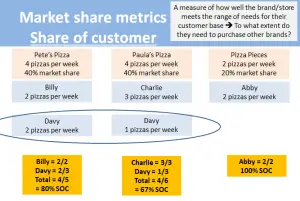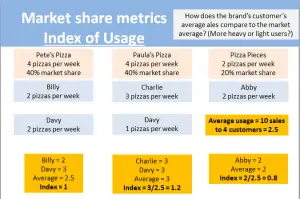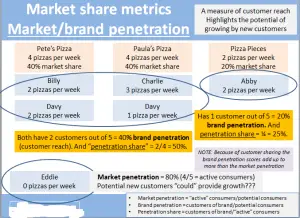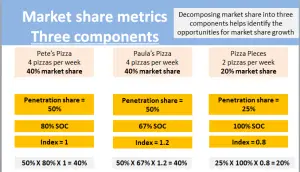Updated May 2023
As we know the revenue and unit market shares formulas are:
- Market Share = (Company’s Sales Revenue / Total Market Sales Revenue) * 100
- Market Share = (Company’s Unit Sales / Total Market Unit Sales) * 100
But did you know that market share is made up of three underlying and measurable components?
Contents
It is possible to decompose (break-down)market share into three components, namely
- Share of customer
- Penetration share and
- Usage index
Let’s work through an example for a pizza market in a small town to understand how to decompose market share.
NOTE: Please click to enlarge the figures/diagrams.
 In this example there are five potential consumers and three pizza stores and a total of 10 pizza per week is the market size.
In this example there are five potential consumers and three pizza stores and a total of 10 pizza per week is the market size.
You should note that market shares on the right-hand side have been determined by unit sales, not revenue sales.
You should also note that the fifth consumer, Eddie, has not bought any pizzas – that means he is a potential consumer or a non-consumer. This becomes important in how to calculate and decompose market share.
Keeping reading about the market share factors, or review the following video on how to decompose (split up) market shares
Let’s work through the above market, to identify what metrics can be constructed.
I have reorganized the market by consumer in this second diagram – you should note that Billy and Charlie and Abby only buy pizzas from one particular store, whereas Davy makes purchases from two different stores.
The market share metrics we can construct are as follows:
- Unit market share for each particular store (store sales/total market sales)
- Brand penetration – which is the number of customers the store sells to as a percentage of the number of POTENTIAL consumers in the marketplace
- Market penetration – which is the number of customers that ALL stores sell to as a percentage of the number of POTENTIAL consumers in the market
- Penetration share – which is the number of consumers the store sells to as a percentage of the ACTUAL number of customers in the market
From the above metrics you should note that market and brand penetration of based upon the number of potential consumers – whether or not they buy the product (that is, an active consumer). The calculations for marketing and brand penetration would include Eddie who was a non-consumers during the period.
These two metrics differ from penetration share that uses the number of active/actual customers in the period as the denominator in the formula. Penetration share is one of the three components of market share when it is decomposed.
Share of customer is a key marketing metric and is one of the foundations of market share.
As you can see in the diagram, we look to calculate the percentage of the consumer’s total purchases that we gain. In this simple example, Davy buys three items per week across two stores, so the first store has 67% of his business and the second store has 33%.

Each of the other customers deal exclusively with one store, so they all have 100% share of customer. We then have these total purchases up, and compared to the total sales we would have achieved if we had won 100% of the consumer’s business. This is shown as SOC, or share of customer, in the above diagram. Please note that share of customer is sometimes referred to as share of requirements.
Usage index
The usage index is sometimes referred to as the heavy use index (HUI) as well. It is designed to measure whether or not the firm’s consumers are available below average purchasers.

As you can see in this diagram, we are only interested in the number of purchases made by the consumer overall, not a particular store. Therefore, as you can see in this case, Davy has made three purchases across two stores, but we count his three purchases in total.
We only looking at active consumers – who have bought 10 pizzas across four consumers – making an average of 2.5 each. We then compare the average purchases of each customer of each store (note that Davy is counted twice).
As you can see, the third store attracts slightly below average consumers based on purchase volume, whereas the second store attracts a slightly higher purchase quantity.
Now we have calculated the three components of market share: penetration share, share of customer, and usage index – we can now demonstrate how those three components work together to calculate overall unit market share.
As shown in this final diagram, each of the three metrics can be multiplied together to determine the market share percentage.
Decomposing market share is a helpful tool to identify opportunities for growth. Usually firms are looking to grow market share – but do we need to attract new customers?
Or perhaps still need to grow our share of customer? Or do we need to attract heavy users?
The three components of market share help us answer this strategic question.
What are the three components of market share?
The three components of market share are:
a) Share of customer
b) Penetration share
c) Usage index
What is brand penetration?
Brand penetration is the percentage of customers a store sells to out of the total number of potential consumers in the market.
How is market penetration calculated?
Market penetration is calculated as the percentage of customers that all stores sell to out of the total number of potential consumers in the market.
What is penetration share?
Penetration share is the percentage of consumers a store sells to out of the actual number of customers in the market.
What does “share of customer” refer to?
Share of customer is a metric that calculates the percentage of a consumer’s total purchases that a particular store gains.
What is the usage index?
The usage index, also known as the heavy use index (HUI), measures whether a firm’s consumers make purchases below or above the average.
How do the three components of market share work together?
The three components, namely penetration share, share of customer, and usage index, can be multiplied together to calculate the overall unit market share.
How can decomposing market share help identify growth opportunities?
Decomposing market share helps identify specific areas for growth. By analyzing the three components, a firm can determine whether it needs to attract new customers, increase its share of existing customers, or target heavy users to expand market share.
Further Information



